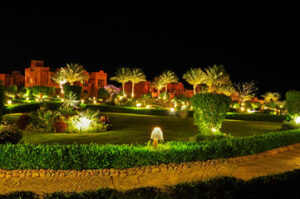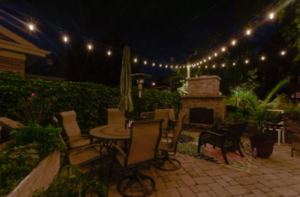As homeowners spend more time in their outdoor living spaces, Landscape Lighting Harrisburg PA is becoming a popular option. It highlights design features, provides safety, and adds a home’s curb appeal.
Contractors need to be familiar with the latest innovations in landscape lighting so they can properly educate their clients and help them choose the best options.

Smart Lighting
Adding landscape lighting to your home offers curb appeal, increased value, better nighttime use of outdoor spaces, and greater safety and security. However, integrating smart technology for landscape lighting takes these benefits to the next level.
A smart landscape lighting controller allows you to control your lights using a smartphone, tablet, or computer. This flexibility allows you to create a range of different lighting effects, from setting the lights to turn off at a specific time for security to creating a dance party atmosphere by having the lights pulsate or change colors.
In addition to allowing you to change the timing of your lights, a smart landscape lighting system also helps save energy. LED systems use very little power, and a smart controller can help you reduce your energy usage by turning the lights off when they aren’t needed.
When you add a smart landscape lighting system, you can expand the number of fixtures and the variety of effects over time. For example, you can add voice-controlled tunable bulbs to your existing path lights, install dramatic spotlights on architectural features, and put in purpose-specific security floodlights by doorways.
A smart lighting system can also integrate with your home security system. This enables you to set up a scene that activates your outdoor lights at dusk and turns them off at a time of your choosing while you’re on vacation, for instance.
As the demand for smart home technologies increases, so will the opportunities for landscaping that integrate with these advancements. We’re excited to be able to offer these advanced solutions for our client’s homes and businesses. Get in touch with us today to learn more about how we can transform your space with the latest in landscape lighting integration.
Energy-Efficient Lighting
Landscape lighting is a powerful way to elevate your property’s visual appeal after the sun goes down. It can be used to accentuate walkways, draw attention to architectural features, and highlight gardens, trees, and shrubs. But it can also be a beautiful and subtle way to create intrigue and drama that adds elegance and a sense of prestige to your home or business.
Incorporating energy-efficient LED lighting into your landscape design offers a host of benefits that go beyond increasing your property’s curb appeal. The most obvious benefit is energy savings. LED lights use significantly less electricity than traditional bulbs and diodes, resulting in lower power bills and substantial cost savings over time.
Another benefit of choosing LED lighting is its long lifespan. LED bulbs and diodes are designed to last significantly longer than traditional lighting options, reducing the need for replacements and maintenance calls. This extends the life of your landscape lighting and maximizes the efficiency of your system.
A final advantage of using energy-efficient lighting in your landscape is its impact on the environment. LED bulbs are more eco-friendly than traditional lighting solutions because they don’t generate much heat. They convert up to 95 percent of their energy into light while generating only about five percent of the heat that is emitted by traditional bulbs.
Additionally, LED lights are made of durable and sturdy materials that can withstand harsh weather conditions. In addition, LEDs are versatile and can be easily integrated with smart lighting systems to increase energy savings and convenience. Incorporating motion sensors and timers into your landscape lighting system can further help reduce energy costs by ensuring that your property is only being lit when it’s needed.
LED Fixtures
The luminous, directional light produced by integrated LED fixtures is perfect for accenting landscaping features, outdoor kitchens, seating walls, and other hardscape structures. The technology behind these lights allows you to easily control your landscape lighting, adjusting brightness and color from the comfort of your home or on the go with your smartphone or tablet.
Integrated LED lights also have a longer lifespan than standard bulbs, meaning they can stay on for more time without needing replacement. This reduces the overall cost of your landscape lighting system, lowering both upfront costs and long-term expenses.
A well-lit exterior of a home sends a message that the property is occupied and protected, deterring burglars and intruders. However, leaving lights on for the entire night may increase energy usage and contribute to unnecessary light pollution. Integrating smart landscape lighting technology like lighting controls and motion sensors can help you balance the needs of security and energy conservation. Your lights can be set to automatically turn on and off at scheduled intervals, or activated in response to motion detection.
When choosing integrated lighting, homeowners can choose from a wide variety of designs to complement their aesthetic preferences and meet their functional goals. For example, recessed, flush-mount integrated lighting can be mounted flat against the ceiling for a minimal, low-profile appearance. Or, a semi-flush mount fixture can be embraced by a decorative crown for a more traditional look. Many of these options also come in a variety of finishes that can be customized to match the color palette of your landscape design. Changing the color of your landscape lighting can also affect its atmosphere and sense of safety. For example, warm white lights (ranging from 3000K to 5000K) can create a comfortable environment that highlights the natural beauty of your landscaping and architectural features. On the other hand, cooler white lights (ranging from 4000K to 6000K) can be used to illuminate pathways and dark corners, promoting safety by increasing the visibility of any potential hazards or obstacles.
Motion Sensors
A motion sensor allows a homeowner to light up only when there’s activity, eliminating unnecessary energy consumption. It can also be used to activate outdoor lighting to provide security and safety, such as in parks and public areas, by adjusting the lighting flux based on people’s passage.
Depending on the type of sensor you have, it may work by using different detection technologies. This is because each one has its working mechanism to suit specific environments and applications.
Most commonly, a motion sensor light works with a PIR (passive infrared) sensor, which detects the heat signature of moving objects to trigger lights to illuminate. These sensors have a built-in phototransistor that has two photoactive areas, so they can convert infrared radiation into an electrical signal. It can sense even the slightest change in signal, such as a person moving, so it can respond very quickly.
Another popular type of sensor is a microwave one, which uses pulses of microwaves to measure the reflection rate of an object. It then compares that to the background and looks for any changes in the rate, which can be detected as a movement. It consumes more energy than a PIR sensor but is less susceptible to interference.
It is important to know how your sensor works and how to adjust its settings according to your needs and environment. For example, you should place your sensor away from radiators and heating vents that can create a sudden change in temperature or HVAC-related airflow and trigger false alarms. In addition, it is advisable to test your sensor’s ability to detect motion by walking around its range of coverage while it is turned on.
Custom Design
While landscape lighting might not be at the top of most homeowners’ home design to-do lists, it shouldn’t be considered an afterthought either. Professionally designed and installed landscape lighting can dramatically improve the appearance of your property and increase its usability after dark as well as during the day.
A lighting designer will be able to provide you with expert advice on how to effectively light your space, helping you to avoid common mistakes like over-illumination or light trespass. Over-illumination occurs when a fixture is too bright, while light trespass happens when the light from a yard or garden spills onto a neighbor’s property and into their home.
When it comes to lighting, every detail counts. For example, using the right color temperature of a bulb can help you achieve different effects. Cooler temperatures highlight greens and blues, while warm colors accentuate brown tones and bring out the richness of trees, flowers, and other plants. Luckily, current LED technology allows you to easily change the color of your fixtures with the touch of a button. This allows for an infinite amount of options to elevate your landscape lighting compositions to the next level.
Integrating the latest technology into your landscape lighting system can give you an edge over your competition and enhance your overall outdoor experience. A professional landscape lighting designer will have a deep understanding of electrical wiring and safety regulations, ensuring your lighting system is installed properly and works correctly for years to come. By choosing the right technology for your landscape lighting, you can enjoy your outdoor space to the fullest and make your property stand out on a crowded block.

